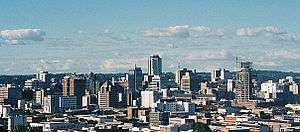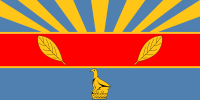Harare
| Harare Salisbury (official name until 1982) | |||
|---|---|---|---|
| City | |||
|
Skyline of Harare, Capital of Zimbabwe | |||
| |||
| Nickname(s): Sunshine City, H Town | |||
|
Motto:
| |||
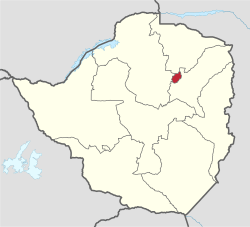 Location of Harare in Zimbabwe | |||
| Coordinates: 17°51′50″S 31°1′47″E / 17.86389°S 31.02972°ECoordinates: 17°51′50″S 31°1′47″E / 17.86389°S 31.02972°E | |||
| Country | Zimbabwe | ||
| Province | Harare | ||
| Founded as Fort Salisbury | 1890 | ||
| Incorporated (city) | 1935 | ||
| Renamed to Harare | 1982 | ||
| Government | |||
| • Mayor | Bernard Manyenyeni[1] | ||
| Area | |||
| • City | 960.6 km2 (370.9 sq mi) | ||
| Elevation | 1,490 m (4,890 ft) | ||
| Population (2009) | |||
| • City | 1,606,000 | ||
| • Density | 2,540/km2 (4,330/sq mi) | ||
| • Urban | 1,619,000 (March 2,013)[2] | ||
| estimated | |||
| Demonym(s) | Hararean | ||
| Time zone | CAT (UTC+2) | ||
| Area code(s) | 4 | ||
| Climate | Cwb | ||
| Website |
hararecity | ||
| Dialling code 4 (or 04 from within Zimbabwe) | |||
Harare (/həˈrɑːreɪ/;[3] officially called Salisbury until 1982[4]) is the capital and most populous city of Zimbabwe. Situated in the north-east of the country in the heart of historic Mashonaland, the city has an estimated population of 1,606,000 (2009),[5] with 2,800,000 in its metropolitan area (2006). Administratively, Harare is a metropolitan province, which also incorporates Chitungwiza town and Epworth.[6] It is situated at an elevation of 1,483 metres (4,865 feet) above sea level and its climate falls into the subtropical highland category.
The city was founded in 1890 by the Pioneer Column, a small military force in the service of the British South Africa Company, and named Fort Salisbury after the British Prime Minister Lord Salisbury. Company administrators demarcated the city and ran it until Southern Rhodesia achieved responsible government in 1923. Salisbury was thereafter the seat of the Southern Rhodesian (later Rhodesian) government and, between 1953 and 1963, the capital of the Central African Federation. It retained the name Salisbury until 1982, when it was renamed Harare on the second anniversary of Zimbabwean independence.
Harare is Zimbabwe's leading financial, commercial, and communications centre, and a trade centre for tobacco, maize, cotton, and citrus fruits. Manufactured goods include textiles, steel and chemicals, and gold is mined in the area. The city's suburbs include Borrowdale,Helensvale, Greendale, Chisipite, Mbare, HIghfields, Kuwadzana, Marlboro, Marlbereign, Vainona, Mount Pleasant and Avondale; the most affluent neighbourhoods are to the north. The University of Zimbabwe, the country's oldest university (founded in 1952), is situated in Mount Pleasant, about 6 km (3.7 mi) north of the city centre.[7] Harare is home to the country's main Test cricket ground, Harare Sports Club, and to Dynamos F.C., Zimbabwe's most successful association football team.
History
Colonial and UDI period (1890–1979)
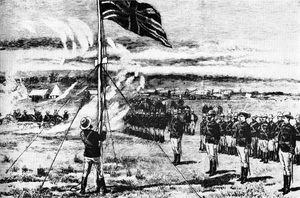
The Pioneer Column, a military volunteer force of settlers organised by Cecil Rhodes, founded the city on 12 September 1890 as a fort.[8] They originally named the city Fort Salisbury after The 3rd Marquess of Salisbury, then British Prime Minister, and it subsequently became known simply as Salisbury. The Salisbury Polo Club was formed in 1896.[9] It was declared to be a municipality in 1897 and it became a city in 1935.
The area at the time of founding of the city was poorly drained and earliest development was on sloping ground along the left bank of a stream that is now the course of a trunk road (Julius Nyerere Way). The first area to be fully drained was near the head of the stream and was named Causeway as a result. This area is now the site of many of the most important government buildings, including the Senate House and the Office of the Prime Minister, now renamed for the use of President Mugabe after the position was abolished in January 1988.[10]
Salisbury was the capital of the self-governing British colony of Southern Rhodesia from 1923, and of the Federation of Rhodesia and Nyasaland from 1953 to 1963. Ian Smith's Rhodesian Front government declared Rhodesia independent from the United Kingdom on 11 November 1965, and proclaimed the Republic of Rhodesia in 1970. Subsequently, the nation became the short-lived state of Zimbabwe Rhodesia; it was not until 18 April 1980 that the country was internationally recognised as independent as the Republic of Zimbabwe.
Post-independence (1980–1998)
The capital city retained the name Salisbury until 1982.
The name of the city was changed to Harare on 18 April 1982, the second anniversary of Zimbabwean independence, taking its name from the village near Harare Kopje of the Shona chief Neharawa, whose nickname was "he who does not sleep".[11] Prior to independence, "Harare" was the name of the black residential area now known as Mbare.
Economic difficulties and hyperinflation (1999–2008)
In the early 21st century Harare has been adversely affected by the political and economic crisis that is currently plaguing Zimbabwe, after the contested 2002 presidential election and 2005 parliamentary elections. The elected council was replaced by a government-appointed commission for alleged inefficiency, but essential services such as rubbish collection and street repairs have rapidly worsened, and are now virtually non-existent. In May 2006 the Zimbabwean newspaper the Financial Gazette, described the city in an editorial as a "sunshine city-turned-sewage farm".[12] In 2009, Harare was voted to be the toughest city to live in according to the Economist Intelligence Unit's livability poll.[13] The situation was unchanged in 2011, according to the same poll, which is based on stability, healthcare, culture and environment, education, and infrastructure.[14]
Operation Murambatsvina
In May 2005 the Zimbabwean government demolished shanties and backyard cottages in Harare and the other cities in the country in Operation Murambatsvina ("Drive Out Trash"). It was widely alleged that the true purpose of the campaign was to punish the urban poor for supporting the opposition Movement for Democratic Change and to reduce the likelihood of mass action against the government by driving people out of the cities. The government claimed it was necessitated by a rise of criminality and disease. This was followed by Operation Garikayi/Hlalani Kuhle (Operation "Better Living") a year later which consisted of building concrete housing of poor quality.
2009–present
In late March 2010, Harare's Joina City Tower was finally opened after 14 years of on-off construction, marketed as Harare's new Pride.[15] Initially, uptake of space in the tower was low, with office occupancy at only 3% in October 2011.[16] By May 2013, office occupancy had risen to around half, with all the retail space occupied.[17]
The Economist Intelligence Unit rated Harare as the world's least liveable city out of 140 surveyed in February 2011,[18] rising to 137th out of 140 in August 2012.[19]
Future plans
During late 2012, plans to build a new capital district in Mt. Hampden, about twenty kilometres (12 miles) north-west of Harare's central business district, were announced and illustrations shown in Harare's daily newspapers. The location of this new district would imply an expansion into Zvimba District. The plan generated varied opinions.[20]
In March 2015, Harare City Council planned a two-year project to install 4,000 solar streetlights, at a cost of $15 million, starting in the central business district.[21]
Geography
Topography
The city sits on the one of the higher parts of the Highveld plateau of Zimbabwe at an elevation of 1,483 metres (4,865 feet). The original landscape could be described as a "parkland."[22]
Climate
Harare has a pleasant subtropical highland climate (Köppen Cwb). The average annual temperature is 17.95 °C (64.3 °F), rather low for the tropics, and this is due to its high altitude position and the prevalence of a cool south-easterly airflow.[23]
There are three main seasons: a warm, wet season from November to March/April; a cool, dry season from May to August (corresponding to winter in the Southern Hemisphere); and a hot, dry season in September/October. Daily temperature ranges are about 7–22 °C (45–72 °F) in July (the coldest month), about 15–29 °C (59–84 °F) in October (the hottest month) and about 16–26 °C (61–79 °F) in January (midsummer). The hottest year on record was 1914 with 19.73 °C (67.5 °F) and the coldest year was 1965 with 17.13 °C (62.8 °F).
The average annual rainfall is about 825 mm (32.5 in) in the southwest, rising to 855 mm (33.7 in) on the higher land of the northeast (from around Borrowdale to Glen Lorne). Very little rain typically falls during the period May to September, although sporadic showers occur most years. Rainfall varies a great deal from year to year and follows cycles of wet and dry periods from 7 to 10 years long. Records begin in October 1890 but all three Harare stations stopped reporting in early 2004.[24]
The climate supports a natural vegetation of open woodland. The most common tree of the local region is the Msasa Brachystegia spiciformis that colours the landscape wine red with its new leaves in late August. Two South American species of trees, the Jacaranda and the Flamboyant, which were introduced during the colonial era, contribute to the city's colour palette with streets lined with either the lilac blossoms of the Jacaranda or the flame red blooms from the Flamboyant. They flower in October/November and are planted on alternative streets in the capital. Also prevalent is Bougainvillea.
| Climate data for Harare (1961–1990, extremes 1897–present) | |||||||||||||
|---|---|---|---|---|---|---|---|---|---|---|---|---|---|
| Month | Jan | Feb | Mar | Apr | May | Jun | Jul | Aug | Sep | Oct | Nov | Dec | Year |
| Record high °C (°F) | 33.9 (93) |
35.0 (95) |
32.3 (90.1) |
32.0 (89.6) |
30.0 (86) |
27.7 (81.9) |
28.8 (83.8) |
31.0 (87.8) |
35.0 (95) |
36.7 (98.1) |
35.3 (95.5) |
33.5 (92.3) |
36.7 (98.1) |
| Average high °C (°F) | 26.2 (79.2) |
26.0 (78.8) |
26.2 (79.2) |
25.6 (78.1) |
23.8 (74.8) |
21.8 (71.2) |
21.6 (70.9) |
24.1 (75.4) |
28.4 (83.1) |
28.8 (83.8) |
27.6 (81.7) |
26.3 (79.3) |
25.5 (77.9) |
| Daily mean °C (°F) | 21.0 (69.8) |
20.7 (69.3) |
20.3 (68.5) |
18.8 (65.8) |
16.1 (61) |
13.7 (56.7) |
13.4 (56.1) |
15.5 (59.9) |
18.6 (65.5) |
20.8 (69.4) |
21.2 (70.2) |
20.9 (69.6) |
18.4 (65.1) |
| Average low °C (°F) | 15.8 (60.4) |
15.7 (60.3) |
14.5 (58.1) |
12.5 (54.5) |
9.3 (48.7) |
6.8 (44.2) |
6.5 (43.7) |
8.5 (47.3) |
11.7 (53.1) |
14.5 (58.1) |
15.5 (59.9) |
15.8 (60.4) |
12.3 (54.1) |
| Record low °C (°F) | 9.6 (49.3) |
8.0 (46.4) |
7.5 (45.5) |
4.7 (40.5) |
2.8 (37) |
0.1 (32.2) |
0.1 (32.2) |
1.1 (34) |
4.1 (39.4) |
5.1 (41.2) |
6.1 (43) |
10.0 (50) |
0.1 (32.2) |
| Average precipitation mm (inches) | 190.8 (7.512) |
176.3 (6.941) |
99.1 (3.902) |
37.2 (1.465) |
7.4 (0.291) |
1.8 (0.071) |
2.3 (0.091) |
2.9 (0.114) |
6.5 (0.256) |
40.4 (1.591) |
93.2 (3.669) |
182.7 (7.193) |
840.6 (33.094) |
| Average precipitation days | 17 | 14 | 10 | 5 | 2 | 1 | 0 | 1 | 1 | 5 | 10 | 16 | 82 |
| Average relative humidity (%) | 76 | 77 | 72 | 67 | 62 | 60 | 55 | 50 | 45 | 48 | 63 | 73 | 62 |
| Mean monthly sunshine hours | 217.0 | 190.4 | 232.5 | 249.0 | 269.7 | 264.0 | 279.0 | 300.7 | 294.0 | 285.2 | 231.0 | 198.4 | 3,010.9 |
| Mean daily sunshine hours | 7.0 | 6.8 | 7.5 | 8.3 | 8.7 | 8.8 | 9.0 | 9.7 | 9.8 | 9.2 | 7.7 | 6.4 | 8.2 |
| Source #1: World Meteorological Organization,[25] NOAA (sun and mean temperature, 1961–1990),[26] | |||||||||||||
| Source #2: Deutscher Wetterdienst (humidity, 1954–1975),[27] Meteo Climat (record highs and lows)[28] | |||||||||||||
Government
Mayors
- Dr Tizirai Gwata (1981–1984)[29]
- Eng Oliver Chidawu (1984–1985)
- Ald. Jabulani Thembani (1988–1989)
- Simon Chikwavaire (1989–1993)
- Charles Tawengwa (1993–1995)
- Tony Gara (1995–1996)
- Solomon Tawengwa (1996–1998)
- KJS Kelvin J Sithole (1998—2002)
- Eng Elias Mudzuri (2002–2003)
- Muchadeyi Masunda (2008–2013)
- Bernard Manyenyeni (2013–)[1]
Suburbs
These are some of the suburbs of Harare.

| Region | Suburbs |
|---|---|
| Northern | Alexandra Park; Avenues; Avondale, Belgravia; Groombridge; Gun Hill; Kensington; Mount Pleasant; Northwood; Newlands; Vainona |
| North-Eastern | Ballantyne Park; Borrowdale; Borrowdale Brooke; Borrowdale West; Chisipite; Mandara(Lichendale); Colne Valley; Colray; Dawn Hill; Donnybrook; Eastlea; Glen Lorne; Glenwood; The Grange; Greendale; Greystone Park; Hatcliffe; Highlands; Helensvale; Hogerty Hill; Kambanji; Lewisam; Luna; Mandara; Philadelphia; Pomona; Quinnington; Rhodesville; Rietfontein; Rolf Valley; Runniville; Chishawasha Hills; Umwinsdale |
| Eastern | Amby; Athlone; Beverley; Beverley West; Chizhanje; Coronation Park; Green Grove; Hillside; Mabvuku; Manresa; Msasa; Letombo Park; Tafara; Eastlea |
| Southern (incl. South-Eastern and South-Western) | Arcadia; Ardbennie; Aspindale Park; Braeside; Budiriro; Chadcombe; Cranborne; Glen Norah; Glen View; Graniteside; Grobbie Park; Harare Airport; Hatfield; Highfield; Hopley; Houghton Park; Induna; Kutsaga; Lochinvar; Logan Park; Malvern; Msasa Park; Mbare; Midlands; Park Meadowlands; Parktown; Prospect; Queensdale; Rugare; Southerton; St. Martins; Sunningdale; Uplands; Waterfalls; Willowvale; Wilmington Park; Workington |
| Western (incl. North-Western) | Adylinn; Ashbrittle; Ashdown Park; Avonlea; Avondale West; Belvedere North; Belvedere South; Bluff Hill; Bluff Hill Park; Cotswold Hills; Crowborough North; Dzivaresekwa; Emerald Hill; Greencroft; Kambuzuma; Haig Park; Kuwadzana; Lincoln Green; Mabelreign; Marimba Park; Marlborough; Meyrick Park; Milton Park; Monovale; Mufakose; New Marimba; New Marlborough; Ridgeview; Sentosa; Sherwood Park; St. Andrews Park; Strathaven; Sunridge; Sunrise; Tynwald; Tynwald South; Warren Park; Warren Park D; Westlea; Westgate; Budiriro |
The Northern and North Eastern Suburbs of Harare are home to the more affluent population of the city including president Robert Mugabe who lives in Borrowdale Brooke. These northern suburbs are often referred to as 'dales' because of the common suffix -dale found in some suburbs such as Avondale, Greendale and Borrowdale. The dwellings are mostly low density homes of 3 bedrooms or more and these usually are occupied by families.
International venue
Harare has been the location of several international summits such as the 8th Summit of the Non-Aligned Movement (6 September 1986) and Commonwealth Heads of Government Meeting 1991.[30] The latter produced the Harare Declaration, dictating the membership criteria of the Commonwealth. In 1998 Harare was the host city of the 8th Assembly of the World Council of Churches.[31]
In 1995, Harare hosted most of the 6th All-Africa Games, sharing the event with other Zimbabwean cities such as Bulawayo and Chitungwiza. It has hosted some of the matches of 2003 Cricket World Cup which was hosted jointly by Kenya, South Africa and Zimbabwe. Several of the matches were also held in Bulawayo.
The city is also the site of one of the Harare International Festival of the Arts (HIFA), which has featured such acclaimed artists as Cape Verdean singer Sara Tavares.[32]
Transport
The public transport system within the city includes both public and private sector operations. The former consist of ZUPCO buses and National Railways of Zimbabwe commuter trains. Privately owned public transport comprised licensed station wagons, nicknamed emergency taxis until the mid-1990s, when they were replaced by licensed buses and minibuses, referred to officially as commuter omnibuses (Makombi).
The National Railways of Zimbabwe operates a daily overnight passenger train service that runs from Harare to Mutare and another one from Harare to Bulawayo. Harare is linked by long distance bus services to most parts of Zimbabwe.
The largest airport of the country Harare International Airport serves Harare.
Sports
Soccer is most popular among the people of Harare. Harare is home to Harare Sports Club ground. It has hosted many Test, One Day Internationals and T20I Cricket matches. Harare is also home to the Zimbabwe Premier Soccer League clubs Dynamos F.C., Harare City, Black Rhinos F.C. and CAPS United F.C..
News and information
Residents are exposed to a variety of sources for information. In the print media, there is the Herald, Financial Gazette, Zimbabwe Independent, Standard, NewsDay,H-Metro, Daily News and Kwayedza. Since there has been an explosion of online media outlets. These include ZimOnline, ZimDaily, Guardian, NewZimbabwe, Times, Harare Tribune, Zimbabwe Metro, The Zimbabwean, The Zimbabwe Mail[33] and many others; however, a number of factors have combined to effectively eliminate all media except those controlled by the state.
The government controls all the electronic media, though Voice of America, Voice of the people and SW Radio Africa beam broadcasts into the country without the clearance of the regulatory authority.
Notable landmarks and institutions
- 44 Harvest House
- Avonlea Primary School
- Borrowdale Race Course
- Cairns Holdings
- CAPS United F.C.
- Cathedral of St Mary and All Saints, Harare (Anglican)
- CBZ Holdings
- Data Control & Systems
- Dynamos F.C.
- Eastgate Centre
- Gwanzura
- Harare Sports Club
- ICL Building
- Heroes Acre
- Karigamombe Centre
- KG6
- KJS apartment
- Livingstone House
- Mbare Musika
- Munhumatapa Hotel
- Mushandirapamwe Hotel
- National Gallery of Zimbabwe
- National Sports Stadium
- Net*One
- NSSA House
- Parirenyatwa Hospital
- PHD MINISTRIES
- Reserve Bank of Zimbabwe
- Rainbow Towers – formerly Sheraton Hotel
- Roman Catholic Archdiocese of Harare
- Rufaro Stadium
- Sam Levy Village
- Sam Nujoma Street
- United Family International Church[34]
- University of Zimbabwe
- Westgate
- ZANU-PF Headquarters
- Zimbabwe Grounds
- Zimbabwe Museum of Human Sciences
- Zimbabwe Stock Exchange
- Zimbabwe Assemblies of God Africa(ZAOGA)
Image gallery
-

Sam Nujoma Street, view south
-

Downtown Harare, Reserve Bank ahead
-

First Street
-

Along parliament buildings
-

Harare Central Station
-
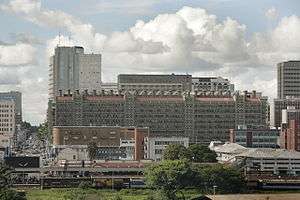
Eastgate centre
-
.jpg)
Relief at National Heroes Acre
-
.jpg)
National Heroes Acre
See also
| Wikivoyage has a travel guide for Harare. |
- Districts of Zimbabwe
- Place names in Zimbabwe
- Provinces of Zimbabwe
- Suburbs of Harare
References
- 1 2 "Mayor 2013–2018". City of Harare. Retrieved 3 December 2013.
- ↑ "Demographia World Urban Areas PDF (March 2013)" (PDF). Demographia. Retrieved 24 November 2013.
- ↑ "Harare". Retrieved 25 May 2015.
- ↑ Names (Alteration) Act Chapter 10:14
- ↑ "The World Factbook — Central Intelligence Agency".
- ↑ Harare Provincial Profile (PDF) (Report). Parliament Research Department. 2011. Retrieved 22 November 2013.
- ↑ University of Zimbabwe Website
- ↑ Hoste, Skipper (1977). N.S.Davies, ed. Gold Fever. Salisbury, Rhodesia: Pioneer Head. ISBN 0-86918-013-4.
- ↑ Horace A. Laffaye, Polo in Britain: A History, Jefferson, North Carolina: McFarland & Company, 2012, p. 76
- ↑ Journal of Frederick Courtney Selous, Rhodesiana Reprint Library, Salisbury, 1969
- ↑ Room, Adrian (2003). Placenames of the World: Origins and Meanings of the Names for Over 5000 Natural Features, Countries, Capitals, Territories, Cities and Historic Sights. McFarland. ISBN 9780786418145.
- ↑ kdc. "The Zimbabwe Situation". zimbabwesituation.com.
- ↑ Agence France-Presse. "Vancouver world's easiest city to live in, Harare worst: Poll". The Vancouver Sun. Calgary Herald. Retrieved 8 June 2009.
- ↑ "Least livable cities". Reuters. Reuters. Retrieved 19 August 2016.
- ↑ "Joina City- Harare's New Pride – Inside Joina City- Facts & Figures". Urbika.com. 31 March 2010. Retrieved 17 June 2013.
- ↑ "Joina City Occupancy 3pc". ForBuilder. 16 October 2011.
- ↑ Moyo, Jason (31 May 2013). "Zimbabwe's Changing Spaces". Mail and Guardian. Retrieved 17 June 2013.
- ↑ Koranyi, Balazs (21 February 2011). "Vancouver still world's most livable city: survey". Reuters. Retrieved 28 September 2012.
- ↑ The Economist Intelligence Unit (August 2012). Liveabililty Ranking and Overview August 2012 (Report). Retrieved 17 June 2013.
- ↑ "Zvimba paradise city revealed". Newsday. 23 November 2012. Retrieved 6 June 2013.
- ↑ Madalitso Mwando (2015-03-27). "Zimbabwe Capital Turns to Solar Streetlights to Cut Costs, Crime". allAfrica.com – Thomson Reuters Foundation. Retrieved 2015-03-28.
- ↑ TV Bulpin: Discovering South Africa pp 838
- ↑ Average for years 1965–1995, Goddard Institute of Space Studies World Climate database
- ↑ Global Historic Climate Network database NGDC
- ↑ "World Weather Information Service – Harare". World Meteorological Organization. Retrieved 10 June 2016.
- ↑ "Harare Kutsaga Climate Normals 1961–1990". National Oceanic and Atmospheric Administration. Retrieved 10 June 2016.
- ↑ "Klimatafel von Harare-Kutsaga (Salisbury) / Simbabwe" (PDF). Baseline climate means (1961–1990) from stations all over the world (in German). Deutscher Wetterdienst. Retrieved 10 June 2016.
- ↑ "Station Harare" (in French). Meteo Climat. Retrieved 10 June 2016.
- ↑ "Former Harare Mayors Meet". City of Harare. 25 October 2013. Retrieved 3 December 2013.
- ↑ List of previous CHOGMS
- ↑ "8th assembly & 50th anniversary". Retrieved 25 May 2015.
- ↑ "What's Next..." reflecting a sense of positive progress". hifa.co.zw. Retrieved 6 June 2013.
- ↑ "The Zimbabwe Mail". Retrieved 25 May 2015.
- ↑ "UFI MINISTRIES". ufiministries.org.
External links

Wikimedia Commons has media related to Harare.
